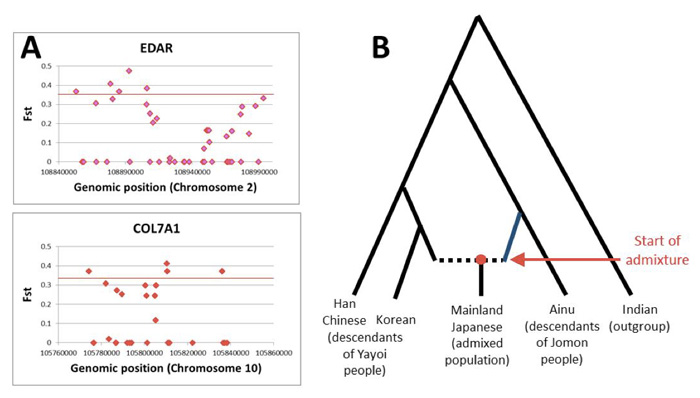Unique characteristics of the Ainu and the establishment of Mainland Japanese inferred from genome-wide SNP data
Division of Population Genetics / Saitou Group
Unique characteristics of the Ainu population in Northern Japan.
Jinam Timothy A, Kanzawa-Kiriyama Hideaki, Inoue Ituro, Tokunaga Katsushi, Omoto Keiichi, and Saitou Naruya.
Journal of Human Genetics. 2015 Jul 16. DOI:10.1038/jhg.2015.79
There are three human populations inhabiting the Japanese Archipelago: the Ainu, mostly living in Hokkaido island in the north; Ryukyuans who mostly reside in the Ryukyu islands in the south; and Mainland Japanese who can be found throughout the Japanese Archipelago. By analyzing up to 600 thousand genome-wide autosomal Single Nucleotide Polymorphisms (SNP) in these populations, we, in collaboration with the University of Tokyo, found that highly differentiated SNPs between the Ainu and the Mainland Japanese are associated with genes (EDAR and COL7A1) related to hair & tooth and facial morphology, respectively (Fig. A). Assuming the Ainu as descendants of the Jomon people (hunter-gatherers) and continental Asians (Han Chinese and Koreans) as descendants of migrant people (farmers) (Fig. B), the proportion of Jomon genetic component in Mainland Japanese was ~20%. The admixture event was estimated to have occurred at least 55 generations ago, or 7th Century. These results clearly demonstrate the unique phylogenetic status of the Ainu people within East Asia. This study was supported by SOKENDAI strategic interdisciplinary research. First author, Timothy A. Jinam, is assistant professor of Saitou Laboratory, coauthor Hideaki Kanzawa-Kiriyama graduated SOKENDAI Department of Genetics in 2014, and Ituro Inoue is professor of Division of Human Genetics at this Institute.

A) Some SNPs residing in two genes related to hair & tooth and facial morphology show large frequency differences between the Ainu and the Mainland Japanese.
B) The admixture model of the Mainland Japanese.















